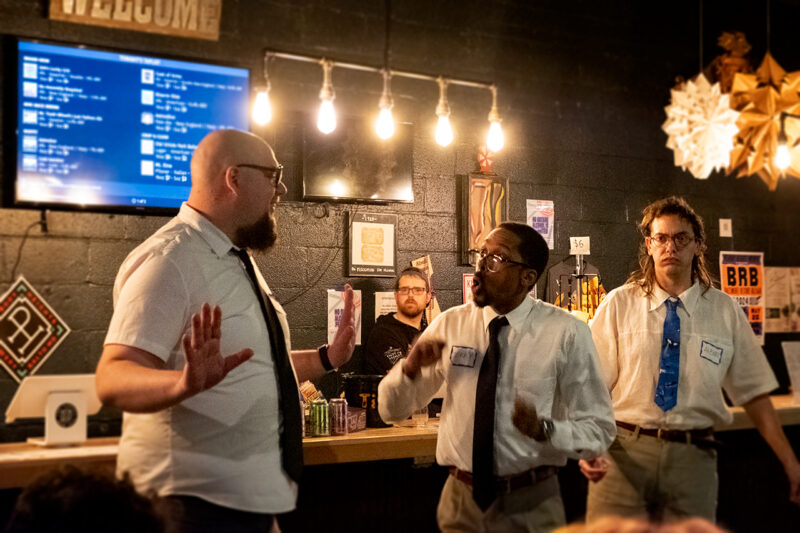The first film produced by new cinematic vanguard The Ummah Chroma Collective demonstrates a turning of the tide
We’re trying to be emanations of the culture. To me, that’s the most radical formation, to be an emanation of the culture. – Arthur Jafa
When was the last time you had a conversation with G/D? As Told to G/D Thyself, a lush short film by a new cinematic vanguard, The Ummah Chroma—Bradford Young, Jenn Nkiru, Terence Nance, Mark Thomas, and Kamasi Washington—imagines encounters with G/D as nonlinear dreamscapes.
In one scene, children hang from the hips of an interstellar mothership. In another, an aged man prays, “Dear Lord, oh Lord, show them the way.” The viewer is asked to submit to a logic of symbols and the collapse of space and time. G/D is a cerebral and salient presence. G/D is an animated universe. G/D is a prodigy practicing the saxophone. G/D is a master teacher encouraging intonation. G/D is a hypnotic head nod in a school-room cypher. G/D is the vitriol of antagonized pitbulls and faceless men. In those moments we are asked to consider divinity through a Black aesthetic, and G/D as an amalgamation of various collective experiences.
Film has not always been kind in its portrayals of non-white narratives. Historically, many of the most celebrated films in western cinema reify devastating stereotypes. That is why this film, and the individual works of The Ummah Chroma members are so refreshing—they confront those histories by de-centering them. Like midwives to a monumental declaration, The Ummah Chroma is a testament to the turning of a tide. “Our time as victims is over,” a voiceover asserts in the film, before cutting to a crisp black and white scene of two elders softly embracing.

As a collective and as individual artists, they have a distinct visual language, a lexicon founded in the radical explorations of the L.A. Rebellion and the liberatory dialectic of Third Cinema, the sonic explorations of Parliament Funkadelic and the transcendental jazz of Sun Ra. For Nkiru, an encounter with G/D is vibrant apparitions and ritual in dense forests. For Nance, it’s a transmission from another universe. For Young and Thomas, G/D is experiments in black and white, the shadowy grain of intimate interiors shot on film, contrasting with hyper-saturated urban landscapes.
Each scene is inspired by songs from Kamasi Washington’s latest record, Heaven and Earth. Washington’s score coupled with Ummah Chroma’s imagery elicits an ecstatic sonic cosmology, a prayer to the power and expansiveness of interdimensional Otherness, African futurists with boundless imagination.
Though the film originally premiered at Sundance Festival 2019, the Baltimore premiere at the Parkway Theatre on February 22 was a highly celebrated event—many scenes were filmed here. Baltimore is a city of innovation and desperate disparity, artistic genius and long-standing inequity. But joy springs in collaboration, legacy, and community contributions to epic visions. In one particularly powerful sequence, students from Green Street Academy and Baltimore School of the Arts burn gigantic bundles of sage in the stairwells of a convent.
The smoke billows up as the chorus of vocalist Patrice Pitman King builds, “Hallelujah, joy springs and everyday a brand-new start. Hallelujah. Joy springs.” At the foundation of The Ummah Chroma’s aesthetic is a deep appreciation for the magical moments that reside in the mundane, the freedom that resounds in the representation of Black innocence and joy. As Told To G/D Thyself visualizes these exhibits in freedom as an improvisational cinema, engaging discontinuity as a profound narrative tool.
As Told To G/D Thyself stands as an homage and continuation, a remembrance and expansion on a legacy of Black creative genius and resistance. “We want to be ushers to the story,” Young noted during a panel discussion with producer/filmmaker Elissa Blount Moorhead at the Baltimore premiere. “We carry the burden of how the dialect is written.” The scenes that comprise As Told To G/D Thyself are coded transmissions that recalibrate our imaginaries by enunciating the beauty of Black culture and community. We are invited to bear witness to the coming of a new age, as told by the people to G/D thyself.

Images are screenshots from the film.






